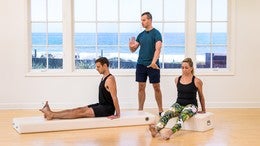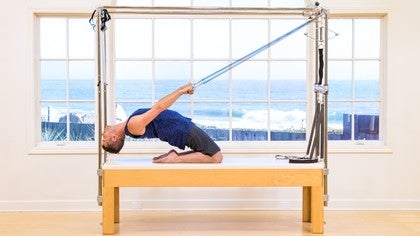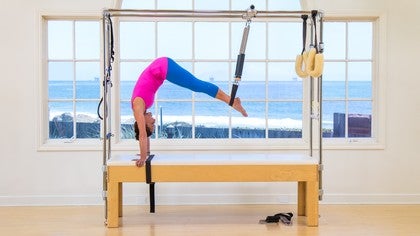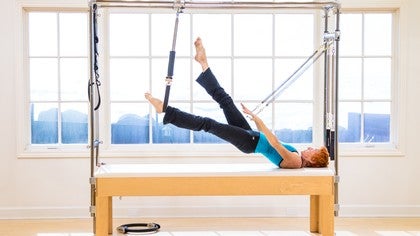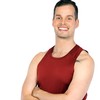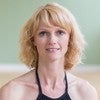Description
About This Video
Transcript
Read Full Transcript
Hi, my name is Benjamin degenhart's. I'm here to share my personal Cadillac practice with you. I do not have a Cadillac and home. I live in New York City. There's no space for Cadillac there, but I do have a set up. I'm outside on my roof deck where I can attach my arms springs, my legs, springs in my roll back, bar springs as well as the next retro which we will be using today as well where it can hook that up and take myself through some of the more basic exercises.
The way that I look at these movements are not necessarily to be a workout as much as just as if you're hitting a light switch in your body to turn on different areas of my body to make sure that I understand how my arms feel that day on my legs. Feel that day that my body is ready for whatever's coming. Whether that's a long day of teaching or sitting at the desk. As I mentioned, we'll be working with a roll back bar and rollback bar springs. I have a set of legs springs attached. I have a set of arms springs attached. You can see that I have them all on the same Hyde, which is exactly how we're using them at home. And I also have a neck stretcher here, which I will attach to a different spot later. These are all grad springs, so they're quite substantial and heavy, which is how I liked them for my practice. Um, you will be able to replicate this practice on a springboard or a tower set up where you don't have, say, push through bar or the hanging straps. Um, here we go. I will always start with, with my roll back just to give my body a chance to, um, see how my back fields to get started on my movement practice here.
I start with my feet down against the Poles, but my knees slightly bent so I can really feel my sits bones down against the mat, set myself up nice and tall, taking a full breath in. And then with my knees bend, I can take my sitz bones towards my heels, begin to crawl through my hips to initiate the movement so I'm not pressing through my feet as much as really reorganizing my hips and then letting my spine slowly lengthen down onto the mat. The spring always supporting me. I come down, I release my head, I like to let the springs pull my arms a little bit here just to see how my neck feels, how my shoulders feel, feels really good and then follow the direction of the spring here, curling up and forward the springs. Pull my arm already where I need them to go. I just have to bend my spine and lift myself back up from there. I'll do that a couple more times just to start mobilizing through my back, waking myself up a little bit, releasing the head, Chin over chest and lift myself back up and I try to maintain as much space in my back as possible. Always re softening the knees at the top.
I'll take one more and because we move our body very often, a forward and backward direction, not so often to the sides. I'll take a little side switch here as well. I take my left hand on top, put my right hand on top of my left so that I'm now holding on mostly with my left turn. I roll myself down to begin my side stretch here. I let the spring bar pull my shoulder as I take my right arm up and over the head. I siphoned my torso to the across my right over my left and I turned my head up towards my top arm and I really just let the springs mobilize my left shoulder. Here. I take a full breath into my right side, huh?
And then a square myself back off feet first spine comes back hand on top. I lift myself back up to the top to do the other side. Probably one of my favorite things to do and pull out. Easy. Roll yourself back down. Release the head, arms swings overhead. Here's my side, Ben. If you have an elevated mad, which I don't have at home or Cadillac, you can even use your hands to create a little traction there.
Letting the shoulder go somewhat turning my head up towards the top arm, breathing into the left side. [inaudible] square myself off again. Foot first spine. Next hand on top. I roll myself up. And then just to square myself off to center myself, I separate my hands so just go back into one roll down here, releasing the head.
I like a Fisker with the hands on the handles, especially for arms springs, just to connect my forum muscles into my shoulder complex. And see if I can let the backs of the shoulders settle down on to the mat and then from here I pull the springs down. There's a lot of tension pulling up and back from the springs. Of course, I'm trying to keep my chest as open as possible, not too concerned with how far my oms go. They ended up on the mat right now, but they may not on any given day. More importantly, I try to keep my ribs down and as you notice I'm staying here for quite a bit. In fact for like probably two or three breaths and I tried to stretch the springs out the entire time. It's like I'm in a competition with myself and I look at the springs and I try to open them up more as I go and then releasing with control.
I think I can even give myself a little bit more tension here, so I do that by moving away from the springs and I go one more time holding the springs down, opening through the chest. If you think of it, this is really your chest expansion just in a very supportive place. On your back. Let's see how this feels with legs long. It feels good. Making sure that my back doesn't arch away from the ground. Keeping myself flush with the mat as much as that's possible and then slowly lifting back up. We'll go into circles from here, pressing down around and when taking my circles, I'm not too concerned with my shoulders staying stiff. In fact, I allow them to lift a little bit off the mat.
I allow them to come closer towards my ears if they really must. I want to keep my back super strong, but my shoulder should be liberated enough to move around, accommodate the circles. I'll reverse the direction or keep the circles a little bit smaller than the second direction just to play around with it. Remember, I'm not trying to get much more out of this rather than connecting my shoulders, my arms
This is probably as close as we get to an isolation of a particular muscle or triceps fold. Here. I'm going to unfold my forms unto the Mat. I try to keep my elbows down, stretch my head back against that, draw my ribs in and then push my elbows into the mat as I slowly release my forms up. Whew. Thanks. Brings out heavy real. Go back down for resting into the mat and almost think about puncturing the mat with my elbows, especially as I lift, keeping the chest open one more time, pressing them just enough to feel those muscles kick in. I know they're on, so they're going to serve me and what's going to happen next. I'm gonna let these guys go and we'll be more armed spring work coming up.
I'll let these guys go. I'll slide myself back just to get my legs springs next body part to put on the grid. I opened the straps, I set myself up. I like an arm length of distance, but it depends on how comfortable you are with the springs. Now this replicates what I do at home as well. My arm swings actually a little further set apart. Then my legs brings, because my hip distance, I want to have the springs pull into my center.
Whereas I want to give my arms a lot of space and pull. That really opens my chest. My arms of course are pressing back into the Poles here. As I said, I like an arm length, depends on the day. I use my hands to press my hips down into the mat and then I think of extending my legs against my arms. So it's really not so much a core exercise as we would think.
It's a leg and arm exercise. Well really it's a full body exercise, so let's just call it that. So I pushed the springs out with not just my feet but with my arms just as much and make my spine really long and then bend my knees back in, leaving the length in my spine and pressing back out. So these are frogs bending back and relaxing the feed because I like to clench them pressing ouch and back. So my arms constantly work here to keep my torso organized against the Mat. To keep my hips heavy as well. Pressing out, coming in.
I'll take one more and I'll just go into a little down and up. I'll try to lift my legs up. I let the springs pull me, it's like a tug of war and I let the springs wind a little and I go as far up as I can keep my hips down there we go and then our press, my legs down as far as they can keep my ribs attached to the mat are here and I'll just do that a couple of more times so that my body knows how far it can take my circles, which is next, pressing the legs down and then I go into my circles from here. After I cleared my movement range, I'll keep these circles fairly small and contained sort of inside what the Cadillac frame gives you here, which is what I don't have at home. I would just have a sky right above me, which is also quite lovely on a nice day, but it's not so much about range of motion just yet. We'll go into a version later where we circled the leg a little bit bigger down, around and up. I'll reverse again.
I'm focusing really hard on not overusing my toes here because they really, really want to like they could move the springs around. They can. We'll take two more down around and up, down, around and up lakes together. It means come in. Now that I've cleared my range, we'll just take a moment here to release my risk for a second and tend to re energize my arms. I'll go into my walking steps. The legs go straight up. I know where I can take my legs because I've cleared that earlier and then we go into the walking steps. Just about five sets down.
I think about pushing the scraps out with my feet and pushing the poles away with my arms and then I'm lengthening my spine down through my tail into the straps up through my head into the Poles. So much so that my hips begin to lift up and I'm starting to hover into a little bridge leg position and lower the hips back down. I bend my knees back end, so it's a full expansion through my spine that allows me to unlived or unweighted rather and lift myself up. It's sort of what begins your airplane. It's begins your short spine massage. It's really also what picks up your legs into the hundred positions.
So this is really great exercise for me to find that dynamic relationship between my legs, my pelvis and my spine. I'll take one more of these. These are harder than you would think. Lower have been my knees in awe and I talked about going into a bigger range of motion with our circles. So for that I just slide myself back a little bit. I'd take my leg straight up, but just lower one leg down. So it's just like the one leg circle on the mat. But I have a strong sensation to my standing leg because that spring is pulling back into me.
I flex this foot so that the strap really pulls into the arch of me. I stretch the right leg up. It's fully supported. I circumduct the hip, meaning I rotate the leg without lifting the hip up, taking the leg across until I meet the other spring. I surf the leg down around and back to center, open down, around and up. I'll take a few more this direction here on the mat. Traditionally the hip is allowed to lift a little bit because it's really a spinal rotation with the support of the spring are quite enjoy keeping the hips steady and seeing how far my hips can mobilize, how far my thigh bone can rotate around my hip socket without a clicking, without making any nasty noises, which it sometimes does.
When there was no spring, I'll reverse what about five times, and again, it's not about making super big circles, but without support of the spring and the support and the feedback of my standing leg. I'll just explore my movement range one more time down across it, up, and then I have the other side. Of course the spring constantly reminds myself that as much as I'm reaching the, like out of my head, there's also an energy that pulls the leg right back into the hip socket
I strengthen and connected my upper body as well as my lower body. So I'm pretty much all connected now. There's a couple more exercises that I want to do now that I've been on the mat nice and supported. Um, I'm going to bring myself up into a kneeling position and the position that we don't work in at all actually [inaudible] traditional glottis. That is is the half kneeling position. Um, we have exercises on the window chair where we step up, for example, going up front and whatnot, um, where we are in a split stance. So I like to warm myself up for that here because that's a very functional range for work through. I want to do chest expansion using my arms, spring handles here you can see that they're about attached to my hip height.
I walk myself in until the handles meet the sides of my thighs. And then I take one foot forward to come into a half kneeling stance. I want my front foot and my back knee at about hip distance apart. I want my hips to be square in both directions, letting the right sitz bone sink down and pulling the right hip back in space. I feel like I'm dragging my front foot back and my back knee forward. Right?
So before I'm even starting to move the springs, there's already a lot of stuff happening in my lower body and that's really what it is about. Can I stabilize this? We shall see. Whoops. It's already difficult. So from here I slipped myself up, I grab onto my handles, I pull my chest open at a try as best as I can to keep that foundation I just built and then slowly come back in and again pulling back and again this was not so much about moving the springs as much as challenging the foundation that you set yourself up. And I'll do one more at the turn of the neck like we will do on the reformer turning my head left straight ahead, come all the way back in. Of course I'll do the other side as well, which typically feels entirely different from the first side. Left hip, sings down, left hip things back, open the chest and sometimes that's all an exercise might be good for to teach you something about your body on a given day. Paulie, arms back, keep the chest open and return right. The idea of chest expansion is to create more space for your breath or your ribs to expand in all directions. Definitely more difficult on this side for me.
Whole back again. I turned my head and left right straight forward and I come back after chest expansion. I have myself down onto both knees. I'll do a little thigh stretch using my roll back bar, which is right here as well. I distance myself, um, a little bit further away so that I can be in an upright position. And the second lean back, I get tension on the spring where my knees are about hip distance apart here and I like to keep my shinbones parallel to one another. I draw them towards one another and I push the tops of my feet, the arches of my feet down into the mat, hopefully having the heel straight up behind me and then I keep my eyes straight forward as I take my body back. As I hinge, I really focus on stretching the thighs more than anything. Right?
We could take this into a backbend and I think I just might, let's see where first I want to make sure the funds in my hips can really process that movement. I lift myself back up. I do one more like that. My tail is chasing that spot right between the knees. My eyes are straight forward on the bar. Here's some not letting, letting my head drop back, and then I lift myself. I by pushing my hips forward and letting the springs do the rest. When it add a back bend to that, when I add a back bend, I want to make sure that I'm not defaulting into my lower back, but that I pull my chest literally out of my ribs, out of my lower back while still keeping the tailbone curling down towards that spot right in between my knees. I'll try to get longer, open the front of my throat, I release my head back and then I return Shin over.
Just deepening the ribs down to then lift myself back up two more times. Take my body back, I hole myself longer. As you're pulling chest, as you're down stretch you open chin over, chest and lifting back up so there's a sense of spine stretch forward in there as well. On the return, take your body back, pull the chest through the arms and lift yourself all the way back up. Oh, that felt lovely. Now I'm going to change my springs around a little bit. This is where my next retro comes in. The next stretcher is a tool that is really about teaching you something about the posture of your cervical spine, your neck alignment. Um, I have a tendency, old habit of a slight forward head posture, fully aware of that. This is one of the things that gives me a lot of relief in the stress that builds up in there as well as just helping me figure that out on my own a little bit. Still working at it. But you know, life's a process.
I'm going to take the role back about down so that out of the way in order to dilute the spring, because I don't want to put this on my neck, um, straight away, I'm gonna use leg springs here to have something heavy to pull against and I'm choosing a high attachment here so that the spring direction pulls me up and forward rather than forward and down. So pieces of equipment that we don't really see much off and modern teaching, which I think is a bummer cause I don't know anyone who doesn't need a little bit help with their neck. I'm actually returning right into outside stretch from here. Once I have that set up you can see how the two springs really pull me into towards the center point and how this spring now is being pulled by the leg springs in one way while I'm pulling it the other direction. Good stuff. So it's nowhere near as crazy as it looks. I'm gonna wrap this around my head.
Top of the spine is right between your ears, so that's essentially where you want to attach this because the strap is bigger than my head. Thankfully I'm going to hold it shot with my hands, but I'm trying not to pull on the spring and I just returned into the exact same thing I just did minus the back bend. We'll just thigh stretch from here, taking my body back. If you just follow the direction of the spring, you can kind of imagine where that pulls me and how that challenges me to keep my head organized on top of my spine. You might even see a change of tone in the muscles around my neck, but I'm really not looking to change my neck at all, not looking to get stronger there as much as just creating an awareness of how I can lift myself out of that. Similar to exercises like Nick Pole, I'll just do that a couple of more times and if the idea of tractioning your neck, it sounds good to you, you might want to ask your Audis teacher to use this next time and if you sat back on the course, there's many other ways to replicate the traction that this gives you, but it's quite a nifty little tool. I'm going to turn the other direction now. We'll do a version of a spine stretch forward. That also happens on my knees, so again, I'm going to put this around my forehead. I'm holding a tight with my hands behind me, but not using my hands to pull.
I go back into my half kneeling stance. So I step one foot forward. I'm now slightly turned out with my front leg, slightly turned out with my back leg so I can move myself forward and back quite easily here cause I'll need that a little bit. Um, this is an exercise that can be done standing as well. I'll do a kneeling for today. I'm going to lean my body forward until the spring taught, but it's not open just yet. I take a deep breath in and then I think of my spine stretch forward is that exhale rounding my head down to the inside of my right knee.
Exhale. Rolling down, emptying the lungs, puffing up the back, lifting back up. I'll take one more. Could do this all day long. Ah, all right. We want to do one more thing while I have to set up, I'm going to stay up on my knees. I'm going to lean sideways from here. So I'm giving myself, um, a stance in which I have, um, a little bit of space to lean out and away from the spring attachment here. This is going to go around my head sideways. Now, what I'm looking for is to strengthen or activate the muscles in the side of my neck, not for the sake of strengthening them, just for the sake of telling them they have a job to do today. Whatever that means. Holding my head up above my head, above my spine is a job.
I want to stand up tall on my left knee here. I'm leaning out to the side and the second the spring catches, I just pause for a second. I'm not looking to open that spring too far. I can already tell this muscle is kicking in. That's all I want out of this and I go right back in. I try to have one long line from my head through my center down into my bottom leg. Again, this is an exercise that you could do standing or leaning your whole body out to the side. There's a little less threatening to the body, but just as effective, right? So if I were to let go, right, knowing that it doesn't slip off, you can see that my head has to push into the strap to hold it out.
That's what's giving me the relief in the state of my neck that I might feel their other side. Again, I'm giving myself an open stance here so that I can lean my body away from the springs. Not For the sake of opening the spring as much as I can just until I see, okay. These guys are kicking in and then I come back. I'll just do a couple of more here just to be even on both sides. I also extend through my right hip, so I'm avoiding sitting back.
I lift myself out of my waist. I come back in, I'll take one more and if my self back up, my neck field's three inches taller, it feels super light. Ah, quite lovely. Um, we're going to finish with one more exercise using this thing and it's essentially exactly where we started. It's like a roll back. I'm not going to take it all that far, but now that I've connected my, my lower body, my spine, my upper body, and the very top of my spine, I just want to come full circle here, put this thing around my head once more and finish with the same movement that I started with. So again, the strap goes around my head. I hold it tight and lift up tall. I'm not leaning my body back. I'm starting to roll myself down, drying my sits bones towards the heels, opening the spring and seeing how that pulls my head up and forward.
Organizing the shape of my spine as you even curves. I'm not defaulting into anyone place and lifting back up from there two more times. So even though I'm flexing my spine right or direction that often we say we shouldn't move the spine so much into because gravity takes us there all the time. It's a wonderful way to feel that you can actually go into that position without feeling compressed. Still lifting yourself out of your back, still making space for your Oregons, for your lungs, for your vertebrae, for your desks. That feels too good. I'll do one more. Curl the tailbone under. Roll yourself back.
Oh, lift yourself back up. Huh? And that is that this is reminiscent of, um, the type of practice that I do at home on a pretty regular basis. Um, I hope you got to take something out of that. Um, try it at home. Let me know what you think.
Tower & Cadillac Workouts: Advanced Cadillac Workouts
Comments
You need to be a subscriber to post a comment.
Please Log In or Create an Account to start your free trial.
